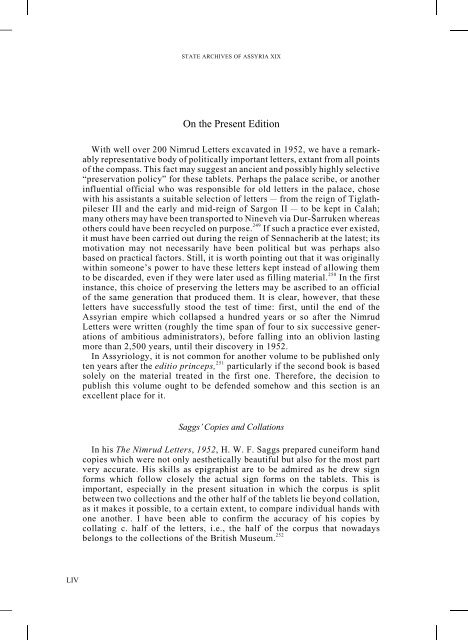Download PDF version of SAA 19 introduction - UCL
Download PDF version of SAA 19 introduction - UCL
Download PDF version of SAA 19 introduction - UCL
Create successful ePaper yourself
Turn your PDF publications into a flip-book with our unique Google optimized e-Paper software.
STATE ARCHIVES OF ASSYRIA XIX<br />
On the Present Edition<br />
With well over 200 Nimrud Letters excavated in <strong>19</strong>52, we have a remarkably<br />
representative body <strong>of</strong> politically important letters, extant from all points<br />
<strong>of</strong> the compass. This fact may suggest an ancient and possibly highly selective<br />
“preservation policy” for these tablets. Perhaps the palace scribe, or another<br />
influential <strong>of</strong>ficial who was responsible for old letters in the palace, chose<br />
with his assistants a suitable selection <strong>of</strong> letters — from the reign <strong>of</strong> Tiglathpileser<br />
III and the early and mid-reign <strong>of</strong> Sargon II — to be kept in Calah;<br />
many others may have been transported to Nineveh via Dur-Šarruken whereas<br />
others could have been recycled on purpose. 249 If such a practice ever existed,<br />
it must have been carried out during the reign <strong>of</strong> Sennacherib at the latest; its<br />
motivation may not necessarily have been political but was perhaps also<br />
based on practical factors. Still, it is worth pointing out that it was originally<br />
within someone’s power to have these letters kept instead <strong>of</strong> allowing them<br />
to be discarded, even if they were later used as filling material. 250 In the first<br />
instance, this choice <strong>of</strong> preserving the letters may be ascribed to an <strong>of</strong>ficial<br />
<strong>of</strong> the same generation that produced them. It is clear, however, that these<br />
letters have successfully stood the test <strong>of</strong> time: first, until the end <strong>of</strong> the<br />
Assyrian empire which collapsed a hundred years or so after the Nimrud<br />
Letters were written (roughly the time span <strong>of</strong> four to six successive generations<br />
<strong>of</strong> ambitious administrators), before falling into an oblivion lasting<br />
more than 2,500 years, until their discovery in <strong>19</strong>52.<br />
In Assyriology, it is not common for another volume to be published only<br />
ten years after the editio princeps, 251 particularly if the second book is based<br />
solely on the material treated in the first one. Therefore, the decision to<br />
publish this volume ought to be defended somehow and this section is an<br />
excellent place for it.<br />
Saggs’ Copies and Collations<br />
In his The Nimrud Letters, <strong>19</strong>52, H. W. F. Saggs prepared cuneiform hand<br />
copies which were not only aesthetically beautiful but also for the most part<br />
very accurate. His skills as epigraphist are to be admired as he drew sign<br />
forms which follow closely the actual sign forms on the tablets. This is<br />
important, especially in the present situation in which the corpus is split<br />
between two collections and the other half <strong>of</strong> the tablets lie beyond collation,<br />
as it makes it possible, to a certain extent, to compare individual hands with<br />
one another. I have been able to confirm the accuracy <strong>of</strong> his copies by<br />
collating c. half <strong>of</strong> the letters, i.e., the half <strong>of</strong> the corpus that nowadays<br />
belongs to the collections <strong>of</strong> the British Museum. 252<br />
LIV

















